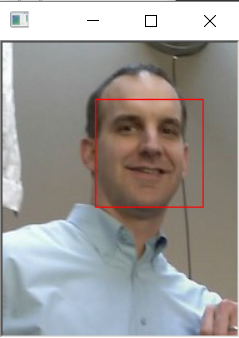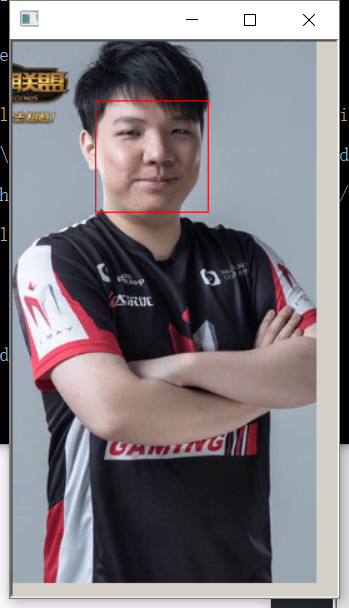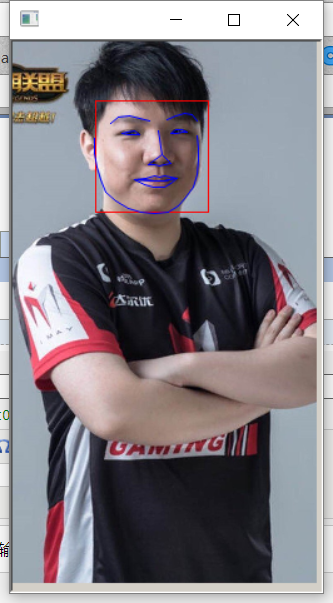学习Python3 Dlib19.7进行人脸面部识别
0.引言
自己在下载dlib官网给的example代码时,一开始不知道怎么使用,在一番摸索之后弄明白怎么使用了;
现分享下 face_detector.py 和 face_landmark_detection.py 这两个py的使用方法;
1.简介
python: 3.6.3
dlib: 19.7
利用dlib的特征提取器,进行人脸 矩形框 的特征提取:
dets = dlib.get_frontal_face_detector(img)
利用dlib的68点特征预测器,进行人脸 68点 特征提取:
predictor = dlib.shape_predictor("shape_predictor_68_face_landmarks.dat")
shape = predictor(img, dets[0])
效果:


(a) face_detector.py
b) face_landmark_detection.py
2.py文件功能介绍
face_detector.py :
识别出图片文件中一张或多张人脸,并用矩形框框出标识出人脸;
link: http://dlib.net/cnn_face_detector.py.html
face_landmark_detection.py :在face_detector.py的识别人脸基础上,识别出人脸部的具体特征部位:下巴轮廓、眉毛、眼睛、嘴巴,同样用标记标识出面部特征;
link: http://dlib.net/face_landmark_detection.py.html
2.1. face_detector.py
官网给的face_detector.py
#!/usr/bin/python
# The contents of this file are in the public domain. See LICENSE_FOR_EXAMPLE_PROGRAMS.txt
#
# This example program shows how to find frontal human faces in an image. In
# particular, it shows how you can take a list of images from the command
# line and display each on the screen with red boxes overlaid on each human
# face.
#
# The examples/faces folder contains some jpg images of people. You can run
# this program on them and see the detections by executing the
# following command:
# ./face_detector.py ../examples/faces/*.jpg
#
# This face detector is made using the now classic Histogram of Oriented
# Gradients (HOG) feature combined with a linear classifier, an image
# pyramid, and sliding window detection scheme. This type of object detector
# is fairly general and capable of detecting many types of semi-rigid objects
# in addition to human faces. Therefore, if you are interested in making
# your own object detectors then read the train_object_detector.py example
# program.
#
#
# COMPILING/INSTALLING THE DLIB PYTHON INTERFACE
# You can install dlib using the command:
# pip install dlib
#
# Alternatively, if you want to compile dlib yourself then go into the dlib
# root folder and run:
# python setup.py install
# or
# python setup.py install --yes USE_AVX_INSTRUCTIONS
# if you have a CPU that supports AVX instructions, since this makes some
# things run faster.
#
# Compiling dlib should work on any operating system so long as you have
# CMake and boost-python installed. On Ubuntu, this can be done easily by
# running the command:
# sudo apt-get install libboost-python-dev cmake
#
# Also note that this example requires scikit-image which can be installed
# via the command:
# pip install scikit-image
# Or downloaded from http://scikit-image.org/download.html.
import sys
import dlib
from skimage import io
detector = dlib.get_frontal_face_detector()
win = dlib.image_window()
for f in sys.argv[1:]:
print("Processing file: {}".format(f))
img = io.imread(f)
# The 1 in the second argument indicates that we should upsample the image
# 1 time. This will make everything bigger and allow us to detect more
# faces.
dets = detector(img, 1)
print("Number of faces detected: {}".format(len(dets)))
for i, d in enumerate(dets):
print("Detection {}: Left: {} Top: {} Right: {} Bottom: {}".format(
i, d.left(), d.top(), d.right(), d.bottom()))
win.clear_overlay()
win.set_image(img)
win.add_overlay(dets)
dlib.hit_enter_to_continue()
# Finally, if you really want to you can ask the detector to tell you the score
# for each detection. The score is bigger for more confident detections.
# The third argument to run is an optional adjustment to the detection threshold,
# where a negative value will return more detections and a positive value fewer.
# Also, the idx tells you which of the face sub-detectors matched. This can be
# used to broadly identify faces in different orientations.
if (len(sys.argv[1:]) > 0):
img = io.imread(sys.argv[1])
dets, scores, idx = detector.run(img, 1, -1)
for i, d in enumerate(dets):
print("Detection {}, score: {}, face_type:{}".format(
d, scores[i], idx[i]))
为了方便理解,修改增加注释之后的 face_detector.py
import dlib
from skimage import io
# 使用特征提取器frontal_face_detector
detector = dlib.get_frontal_face_detector()
# path是图片所在路径
path = "F:/code/python/P_dlib_face/pic/"
img = io.imread(path+"1.jpg")
# 特征提取器的实例化
dets = detector(img)
print("人脸数:", len(dets))
# 输出人脸矩形的四个坐标点
for i, d in enumerate(dets):
print("第", i, "个人脸d的坐标:",
"left:", d.left(),
"right:", d.right(),
"top:", d.top(),
"bottom:", d.bottom())
# 绘制图片
win = dlib.image_window()
# 清除覆盖
#win.clear_overlay()
win.set_image(img)
# 将生成的矩阵覆盖上
win.add_overlay(dets)
# 保持图像
dlib.hit_enter_to_continue()
对test.jpg进行人脸检测:
结果:
图片窗口结果:

输出结果:
人脸数: 1 第 0 个人脸: left: 79 right: 154 top: 47 bottom: 121 Hit enter to continue
对于多个人脸的检测结果:

2.2 face_landmark_detection.py
官网给的 face_detector.py
#!/usr/bin/python
# The contents of this file are in the public domain. See LICENSE_FOR_EXAMPLE_PROGRAMS.txt
#
# This example program shows how to find frontal human faces in an image and
# estimate their pose. The pose takes the form of 68 landmarks. These are
# points on the face such as the corners of the mouth, along the eyebrows, on
# the eyes, and so forth.
#
# The face detector we use is made using the classic Histogram of Oriented
# Gradients (HOG) feature combined with a linear classifier, an image pyramid,
# and sliding window detection scheme. The pose estimator was created by
# using dlib's implementation of the paper:
# One Millisecond Face Alignment with an Ensemble of Regression Trees by
# Vahid Kazemi and Josephine Sullivan, CVPR 2014
# and was trained on the iBUG 300-W face landmark dataset (see
# https://ibug.doc.ic.ac.uk/resources/facial-point-annotations/):
# C. Sagonas, E. Antonakos, G, Tzimiropoulos, S. Zafeiriou, M. Pantic.
# 300 faces In-the-wild challenge: Database and results.
# Image and Vision Computing (IMAVIS), Special Issue on Facial Landmark Localisation "In-The-Wild". 2016.
# You can get the trained model file from:
# http://dlib.net/files/shape_predictor_68_face_landmarks.dat.bz2.
# Note that the license for the iBUG 300-W dataset excludes commercial use.
# So you should contact Imperial College London to find out if it's OK for
# you to use this model file in a commercial product.
#
#
# Also, note that you can train your own models using dlib's machine learning
# tools. See train_shape_predictor.py to see an example.
#
#
# COMPILING/INSTALLING THE DLIB PYTHON INTERFACE
# You can install dlib using the command:
# pip install dlib
#
# Alternatively, if you want to compile dlib yourself then go into the dlib
# root folder and run:
# python setup.py install
# or
# python setup.py install --yes USE_AVX_INSTRUCTIONS
# if you have a CPU that supports AVX instructions, since this makes some
# things run faster.
#
# Compiling dlib should work on any operating system so long as you have
# CMake and boost-python installed. On Ubuntu, this can be done easily by
# running the command:
# sudo apt-get install libboost-python-dev cmake
#
# Also note that this example requires scikit-image which can be installed
# via the command:
# pip install scikit-image
# Or downloaded from http://scikit-image.org/download.html.
import sys
import os
import dlib
import glob
from skimage import io
if len(sys.argv) != 3:
print(
"Give the path to the trained shape predictor model as the first "
"argument and then the directory containing the facial images.\n"
"For example, if you are in the python_examples folder then "
"execute this program by running:\n"
" ./face_landmark_detection.py shape_predictor_68_face_landmarks.dat ../examples/faces\n"
"You can download a trained facial shape predictor from:\n"
" http://dlib.net/files/shape_predictor_68_face_landmarks.dat.bz2")
exit()
predictor_path = sys.argv[1]
faces_folder_path = sys.argv[2]
detector = dlib.get_frontal_face_detector()
predictor = dlib.shape_predictor(predictor_path)
win = dlib.image_window()
for f in glob.glob(os.path.join(faces_folder_path, "*.jpg")):
print("Processing file: {}".format(f))
img = io.imread(f)
win.clear_overlay()
win.set_image(img)
# Ask the detector to find the bounding boxes of each face. The 1 in the
# second argument indicates that we should upsample the image 1 time. This
# will make everything bigger and allow us to detect more faces.
dets = detector(img, 1)
print("Number of faces detected: {}".format(len(dets)))
for k, d in enumerate(dets):
print("Detection {}: Left: {} Top: {} Right: {} Bottom: {}".format(
k, d.left(), d.top(), d.right(), d.bottom()))
# Get the landmarks/parts for the face in box d.
shape = predictor(img, d)
print("Part 0: {}, Part 1: {} ...".format(shape.part(0), shape.part(1)))
# Draw the face landmarks on the screen.
win.add_overlay(shape)
win.add_overlay(dets)
dlib.hit_enter_to_continue()
修改:
绘制两个overlay,矩阵框 和 面部特征
import dlib
from skimage import io
# 使用特征提取器frontal_face_detector
detector = dlib.get_frontal_face_detector()
# dlib的68点模型
path_pre = "F:/code/python/P_dlib_face/"
predictor = dlib.shape_predictor(path_pre+"shape_predictor_68_face_landmarks.dat")
# 图片所在路径
path_pic = "F:/code/python/P_dlib_face/pic/"
img = io.imread(path_pic+"1.jpg")
# 生成dlib的图像窗口
win = dlib.image_window()
win.clear_overlay()
win.set_image(img)
# 特征提取器的实例化
dets = detector(img, 1)
print("人脸数:", len(dets))
for k, d in enumerate(dets):
print("第", k, "个人脸d的坐标:",
"left:", d.left(),
"right:", d.right(),
"top:", d.top(),
"bottom:", d.bottom())
# 利用预测器预测
shape = predictor(img, d)
# 绘制面部轮廓
win.add_overlay(shape)
# 绘制矩阵轮廓
win.add_overlay(dets)
# 保持图像
dlib.hit_enter_to_continue()
结果:
人脸数: 1 第 0 个人脸d的坐标: left: 79 right: 154 top: 47 bottom: 121
图片窗口结果:
蓝色的是绘制的 win.add_overlay(shape) 红色的是绘制的 win.add_overlay(dets)

对于多张人脸的检测结果:

官网例程中是利用sys.argv[]读取命令行输入,其实为了方便我把文件路径写好了,如果对于sys.argv[]有疑惑,可以参照下面的总结:
* 关于sys.argv[]的使用:
( 如果对于代码中 sys.argv[] 的使用不了解可以参考这里 )
用来获取cmd命令行参数,例如 获取cmd命令输入“python test.py XXXXX” 的XXXXX参数,可以用于cmd下读取用户输入的文件路径;
如果不明白可以在python代码内直接 img = imread("F:/*****/test.jpg") 代替 img = imread(sys.argv[1]) 读取图片;
用代码实例来帮助理解:
1.(sys.argv[0],指的是代码文件本身在的路径)
test1.py:
import sys a=sys.argv[0] print(a)
cmd input:
python test1.py
cmd output:
test1.py
2.(sys.argv[1],cmd输入获取的参数字符串中,第一个字符)
test2.py:
import sys a=sys.argv[1] print(a)
cmd input:
python test2.py what is your name
cmd output:
what
(sys.argv[1:],cmd输入获取的参数字符串中,从第一个字符开始到结束)
test3.py:
import sys a=sys.argv[1:] print(a)
cmd input:
python test3.py what is your name
cmd output:
[“what”,“is”,“your”,“name”]
3.(sys.argv[2],cmd输入获取的参数字符串中,第二个字符)
test4.py:
import sys a=sys.argv[2] print(a)
cmd input:
python test4.py what is your name
cmd output:
"is"
您可能感兴趣的文章:
- Python实现识别手写数字 Python图片读入与处理
- Python实现识别手写数字大纲
- python实现识别手写数字 python图像识别算法
- python实现图像识别功能
- Python3结合Dlib实现人脸识别和剪切
- 用Python进行简单图像识别(验证码)
- Python3一行代码实现图片文字识别的示例
- Python用sndhdr模块识别音频格式详解
- Python用imghdr模块识别图片格式实例解析
- Python实现识别手写数字 简易图片存储管理系统

